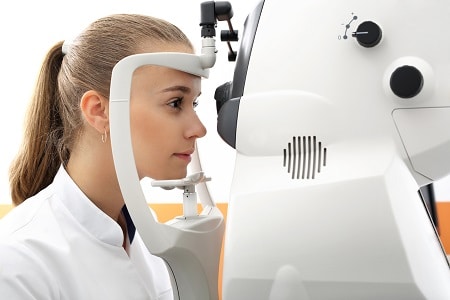Presbyterian/Columbia University Medical Center (CUMC) recently unveiled a state-of-the-art mobile testing unit in a push to reduce blindness-causing eye diseases across the city. The unit, called The Tele-Ophthalmology Unit, is the first of its kind in the country, targeting communities where residents are most vulnerable to four major sight-threatening conditions: glaucoma, cataracts, macular degeneration and diabetic retinopathy.
“You can treat these eye conditions and prevent blindness if they’re caught early,” said Dr. Lama Al-Aswad, an ophthalmologist at NewYork-Presbyterian/Columbia, associate professor of ophthalmology at Columbia University Medical Center and the Director of the Tele-Ophthalmology initiative. “But unfortunately, many people in underserved communities don’t have access to proper eye care, and by the time these diseases progress, it’s often too late. This project leverages technology and mobility to help these patients get the care they need, when they need it.”
Under Dr. Al-Aswad’s leadership, the Tele-Ophthalmology Unit expects to conduct up to 2,000 free screenings each year at locations in the Bronx, Washington Heights and Harlem. Dr. Al-Aswad and her team utilize an array of diagnostic equipment in the mobile testing station, which includes highly secure, WiFi-based data transmission that allows clinicians in NewYork-Presbyterian/Columbia’s reading center to evaluate data in real-time. Screening participants are then given instructions or referrals to clinics that can handle follow-up care.
“Our model pursues health care management by targeting high-risk populations and screening them for diseases free of cost,” said Dr. Al-Aswad. “If we are able to identify these problems in patients before they progress, we’ll reduce the cost of care and improve their health drastically.”
So far, the mobile unit has screened about 160 individuals, with plans to visit Washington Heights, Harlem, Flushing, Fort Greene, Bronx, Queens and Brooklyn later this year.
Ophthalmological diseases and blindness are increasingly becoming a public health problem. “In our old model for community screening, we found that 57% of individuals never saw an eye doctor in their lifetime regardless of having insurance. They may develop a preventable blinding disease such as glaucoma, diabetic retinopathy or macular degeneration without even realizing it,” said Dr. Al-Aswad.
The Tele-Ophthalmology Unit is an innovative approach to combat preventable blindness through critical testing, and one that could become more popular if it proves effective.
NewYork-Presbyterian
NewYork-Presbyterian is one of the nation’s most comprehensive, integrated academic healthcare delivery systems, whose organizations are dedicated to providing the highest quality, most compassionate care and service to patients in the New York metropolitan area, nationally, and throughout the globe. In collaboration with two renowned medical schools, Weill Cornell Medicine and Columbia University Medical Center, NewYork-Presbyterian is consistently recognized as a leader in medical education, groundbreaking research and innovative, patient-centered clinical care.
NewYork-Presbyterian has four major divisions:
NewYork-Presbyterian Hospital is ranked #1 in the New York metropolitan area by U.S. News and World Report and repeatedly named to the Honor Roll of “America’s Best Hospitals.”
NewYork-Presbyterian Regional Hospital Network comprises hospitals and other facilities in the New York metropolitan region.
NewYork-Presbyterian Physician Services, which connects medical experts with patients in their communities.
NewYork-Presbyterian Community and Population Health, encompassing ambulatory care network sites and community healthcare initiatives, including NewYork Quality Care, the Accountable Care Organization jointly established by NewYork-Presbyterian Hospital, Weill Cornell Medicine and Columbia.
For more information, visit www.nyp.org
Columbia University Medical Center
Columbia University Medical Center provides international leadership in basic, preclinical, and clinical research; medical and health sciences education; and patient care. The medical center trains future leaders and includes the dedicated work of many physicians, scientists, public health professionals, dentists, and nurses at the College of Physicians and Surgeons, the Mailman School of Public Health, the College of Dental Medicine, the School of Nursing, the biomedical departments of the Graduate School of Arts and Sciences, and allied research centers and institutions. Columbia University Medical Center is home to the largest medical research enterprise in New York City and State and one of the largest faculty medical practices in the Northeast. The campus that Columbia University Medical Center shares with its hospital partner, NewYork-Presbyterian, is now called the Columbia University Irving Medical Center.
About ColumbiaDoctors
ColumbiaDoctors makes medical history, and changes patients’ lives, every day. We are among the largest faculty medical practices in the Northeast, with more than 1,800 Columbia University Medical Center physicians, surgeons, dentists, and nurses. Our Columbia clinicians and researchers exemplify the excellence for which the University is known around the world. They are renowned for their expertise in specialty and subspecialty care, with more than 230 areas in all. Our clinicians harness the latest in scientific research to deliver the newest, most promising treatments directly to our patients. Many of ColumbiaDoctors clinicians rank among the most highly regarded health care professionals in their fields. Our faculty brings the highest standards of compassionate, collaborative care to our patients at NewYork-Presbyterian Hospital, No. 1 in New York City, its affiliates in the region, and in our offices located in Midtown Manhattan, Washington Heights, the Hudson Valley, and across the tri-state area.
For more information, please visit www.columbiadoctors.org



















